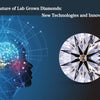
The Future of the Diamond Industry
The diamond industry has always been connected with luxury and elegance because diamond stand for enduring love, commitment, and worth. Yet, the future of this sector is always shifting as a result of new technological advancements and shifting consumer tastes that affect the market. In recent years, worries about concerns including sustainability, ethical sourcing, and the increase in lab-created diamonds have gotten worse.

Many individuals are concerned about the future of the diamond business as a result of this. We'll look at some of the biggest issues and advancements the diamond industry is currently dealing with in this essay and speculatively assess their probable long-term effects.
The Challenges Facing the Diamond Industry
- Sustainability: Diamond mining hurts the environment since it causes deforestation, soil erosion, and water pollution. Diamond mining, cutting, and shipping are energy-intensive processes that add to greenhouse gas emissions, raising concerns about the carbon footprint of the sector.
- Lab-grown diamonds: Consumers, particularly millennials and members of Generation Z, are growing more and more fond of lab-grown diamonds, which are still a relatively new commodity. These diamonds are created in a lab using cutting-edge technology that mimics the natural development of diamonds. They are promoted as a more ethical and ecological alternative to real diamonds because they are frequently less expensive.
- Customer Preferences: Consumer tastes are continually changing, with many younger consumers emphasizing sustainability and ethical sourcing more than older consumers do. Moreover, minimalist and nontraditional engagement rings, some of which may not even include a standard diamond, are becoming more popular.
- Economic Volatility: The demand for diamonds is frequently correlated with consumer confidence and expenditure, making the diamond business highly dependent on global economic conditions. The profitability of mining businesses and diamond retailers can be negatively impacted by economic downturns that result in a major drop in demand for diamonds.
- Technological Disruption: New technologies, like blockchain, which could enhance transparency and traceability in the supply chain, are also posing a threat to the diamond business. New technologies may also be created for diamond mining, cutting, and polishing, which might lower prices and boost productivity.
Many obstacles are preventing the diamond industry's future growth and profitability. In addition to ethical sourcing, sustainability, lab-grown diamond competition, shifting customer preferences, economic volatility, and technological disruption are some of these difficulties. To stay competitive and relevant in the diamond future the industry will need to overcome these issues.
The Rise of Lab-Grown Diamonds
The diamond business is becoming more and more interested in lab-grown diamonds, sometimes referred to as synthetic diamonds. Lab-grown diamonds, as opposed to natural diamonds, are made in a laboratory using cutting-edge scientific techniques. Natural diamonds are mined from the earth. With rising customer demand for an ethical and environmentally benign substitute to mined diamonds, the industry for lab-grown diamonds has expanded quickly in recent years.
To produce lab-grown diamonds, it is necessary to mimic the mantle conditions where diamonds naturally occur. A tiny diamond seed is inserted into a chamber that contains a carbon-rich gas as part of the procedure. After that, the chamber is heated to up to 1,500 degrees Celsius and subjected to tremendous pressure. Layer by layer, the carbon atoms in the gas start to attach to the diamond seed over time, eventually forming a rough diamond. The completed gemstone is produced by cutting and polishing this rough diamond in the same manner as a natural diamond.

The fact that lab-grown diamonds are typically less expensive than natural diamonds is one of their key benefits. This is because they can be produced more effectively, on a bigger scale, and without having to incur the enormous costs of distribution and mining. The supply of lab-grown diamonds is also not subject to the same restrictions and uncertainties as that of natural diamonds, which can cause variations in cost and availability.
Another benefit of lab-grown diamonds is that they are frequently regarded as being a more moral and environmentally responsible alternative to real diamonds. Natural diamond mining has been linked to several social and environmental problems, such as labor exploitation, land degradation, and water contamination. Lab-grown diamonds, on the other hand, are created without the same environmental impact or ethical considerations.
Notwithstanding the benefits of lab-grown diamonds, there are some drawbacks to using them as well. One of the key issues is that consumers do not yet generally recognize synthetic diamonds as a good substitute for genuine diamonds. This is partially because there is a dearth of knowledge and education regarding the advantages and qualities of lab-grown diamonds, which are still relatively new.
Also, some consumers believe that lab-grown diamonds are less valuable and of worse quality than genuine diamonds. While it's true that some laboratory-grown diamonds might differ from natural diamonds in terms of their chemical composition or growth structure, many lab-grown diamonds are visually indistinguishable from natural diamonds. Moreover, lab-grown diamonds can be created in a variety of hues and dimensions, and they are frequently modified to match particular client needs.
Notwithstanding these obstacles, the market for lab-grown diamonds is expanding quickly due to rising consumer demand for a moral and sustainable replacement for natural diamonds. Some well-known diamond companies are already making investments in the creation of lab-grown diamonds in response to this demand, and new businesses are also starting to specialize in the manufacturing and distribution of lab-grown diamonds.
Ethical and Environmental Considerations
Compared to their natural counterparts, lab-grown diamonds are frequently viewed as a more moral and sustainable choice. Natural diamond mining and production have been linked to several social and environmental problems, including labor exploitation, land degradation, and water contamination. The following are some ethical and environmental issues with lab-grown diamonds:
Ethical Considerations:
- Labor Conditions: As lab-grown diamonds are created in a controlled setting, they are produced under considerably more favorable circumstances than wild diamonds that must be mined and cut. Particularly in underdeveloped nations where labor rules are sometimes lax, many diamond mines have been accused of abusing workers and breaching human rights.
- Conflict Diamonds: Diamonds mined in war zones and sold to fund armed conflicts are known as conflict diamonds, while lab-grown diamonds are free from this risk. Conflict diamonds have been linked to several violations of human rights, such as child labor and forced labor.
- Transparency: The manufacture of lab-grown diamonds is a transparent procedure, allowing purchasers to track the origin of the stone and confirm that it was created ethically. The natural diamond sector, on the other hand, has been charged with lacking transparency and accountability, which makes it challenging to verify that diamonds have been sourced ethically.

Environmental Considerations:
- Land Use: Diamond mining has the potential to seriously degrade the environment and destroy wildlife habitat. Contrarily, lab-grown diamonds are created in a controlled environment, negating the need for habitat destruction and land exploitation.
- Water Usage: Diamond mining uses a lot of water, which can deplete water supplies and pollute the environment in water-stressed places. Lab-grown diamonds, on the other hand, have a reduced water impact since they require a lot less water to produce.
- Carbon Footprint: The manufacture of lab-grown diamonds necessitates a substantial amount of energy, which may result in the release of greenhouse gases. Yet, because the production method is more effective and doesn't include heavy gear or transportation, lab-grown diamonds often have a lower carbon footprint than natural diamonds.
- Chemicals: To produce lab-grown diamonds, chemicals must be used, and improper chemical management can have negative effects on the environment. Nonetheless, numerous manufacturers of lab-grown diamonds have created ecologically-friendly manufacturing processes that reduce the usage of dangerous chemicals.
- Recyclability: Lab-grown diamonds have the potential to establish a closed-loop system because they can be recycled and utilized again. In contrast, natural diamonds have a restricted shelf life because they are a scarce resource that cannot be renewed.
While lab-grown diamonds have a smaller ethical and environmental impact than natural diamonds, it's crucial to remember that they still have some negative effects. There are still issues with the disposal of waste products from the production process, and the production of lab-grown diamonds still uses energy and chemicals. However, compared to the environmental and ethical impacts of the natural diamond industry, lab-grown diamonds are generally considered to be a much more sustainable option.
Conclusion
The customer demand for ecological and ethical products is causing a huge shift in the diamond industry as lab-grown diamonds gain popularity. While this sector still dominates the market for natural diamonds, lab-grown diamonds are poised to overtake it and may overtake natural diamonds as the consumer's preferred option.
For the diamond industry, the rise of lab-grown diamonds offers both benefits and challenges. Producers of natural diamonds will need to adjust to shifting consumer demands and discover strategies to set their goods apart from lab-grown diamonds. The lab-grown diamond business will also need to address worries about the negative ethical and environmental effects of production and make sure that its goods are made ethically.
The ability of natural diamond producers to adjust to shifting market conditions and the capacity of lab-grown diamond manufacturers to meet rising demand while reducing their environmental and ethical footprint will ultimately determine the future of the diamond business. Whatever the outcome, it is obvious that the diamond industry is at a turning point and that the choices made now will have a big impact on the industry's future.
If you're looking for high-quality, ethically sourced, and stunning diamond jewelry, look no further than Diamondrensu. Visit our website today to browse our selection of lab-grown diamonds and find the perfect piece for any occasion. Don't miss out on the future of the diamond industry - choose Diamondrensu for sustainable and stylish diamond jewelry.
Leave a comment
Please note, comments must be approved before they are published.


















